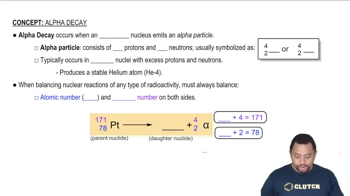Here are the essential concepts you must grasp in order to answer the question correctly.
Half-life
Half-life is the time required for half of the radioactive nuclei in a sample to decay. For Polonium-218, with a half-life of 3.0 minutes, this means that after 3.0 minutes, half of the original amount will have decayed. Understanding half-life is crucial for calculating the remaining quantity of a radioactive substance over time and determining the number of decay events that occur within a specified period.
Recommended video:
Alpha decay
Alpha decay is a type of radioactive decay in which an unstable nucleus emits an alpha particle, consisting of two protons and two neutrons. This process reduces the atomic number of the element by two, transforming it into a different element. In the context of Polonium-218, each decay event results in the emission of an alpha particle, which is essential for calculating the total number of emissions over a given time frame.
Recommended video:
Curie (Ci)
The Curie (Ci) is a unit of radioactivity that quantifies the rate of decay of radioactive materials. One Curie is defined as 3.7 x 10^10 disintegrations per second, which provides a measure of the intensity of radiation emitted by a radioactive source. When assessing the exposure to radiation from ingested Polonium-218, converting the decay events into Curie units helps quantify the potential health risks associated with the radiation exposure.
Recommended video:
Units of Radiation Measurement
 Verified step by step guidance
Verified step by step guidance

